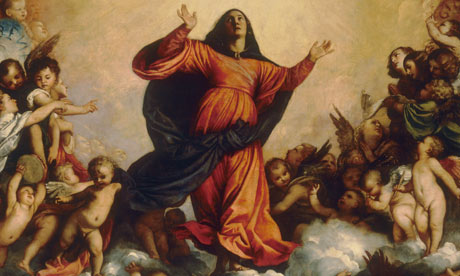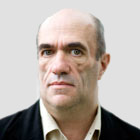It is a short walk in Venice from the Frari to the Scuola Grande di San Rocco. At first, I found only the Frari. I went there some days and sat for as long as I could in front of Titian's painting of the Assumption. I bought postcards of the painting and, once, a larger poster. Every time I left Venice, I always felt guilty that I had not seen enough, or taken enough in, so the time spent in front of the Titian was a way of trying to concentrate more than usual, trying to pull something from the experience of looking that I could keep and remember.
The painting is almost seven metres high, it hangs behind the altar of the church. There are two lovely divisions in the composition. The first division is the pale sky between the shocked mortals who stand on the ground and the cloud above them, lifted by angels, which bears the mother of God in her wonderful red robe, with a blue robe falling away. The second division is the golden sky above Mary, to which she soars with her arms outstretched towards God who is above. This is the sky of heaven.
There is something so pure about the composition that it manages to stretch powerfully beyond the story that Mary, as the mother of God, on her death could not be allowed to decompose in the earth, but was assumed body and soul into heaven. And yet the painting remains rooted also in the sheer glorious shock of such an event, were it to have taken place.
Not far away, in a room within the Scuola Grande di San Rocco, Tintoretto has a painting that came as another sort of shock when I eventually found it. This one is rooted in the real world, rather than the world of dreams where Titian's painting lives. The painting of the crucifixion here is more than 12 metres wide. Its size means that the idea of transcendental space soaring towards the heavens above is replaced with the vast, long, busy world around. Tintoretto shows that while Jesus hung on a cross until he died, many other things happened too. If the sound of the Titian is of angels' unearthly voices, this painting by Tintoretto is filled with the brutal noise of the world.
I think the gap between these two paintings made me wonder about how the imploring, powerless figure of Mary at the foot of the cross as her son was crucified could have become, in Catholic doctrine and Italian painting, the queen of heaven. The more time I spent looking at paintings in Venice the more I came to feel that the story of her transformation fulfilled a pictorial need, or a storyteller's need, as much as it did anything else.
One evening at home, when I was looking at the different versions of the crucifixion in EV Rieu's translation of The Four Gospels, I began to read his introduction. In his account of St John, he mentioned that it was possible that John had read Aeschylus. This made me sit up for a minute, since John was the one who had placed Mary at the foot of the cross and had included the story of Lazarus in his Gospel. The idea that John got some of his inspiration from a Greek source, or that he saw how powerful certain images would be from his knowledge of Greek theatre, made me wonder even more.
It is possible that John wrote his Gospel towards the end of the first century in Ephesus, which is now in Turkey but was then part of the Roman empire. There is now a house in Ephesus which many believe was the house where Mary lived out her last days, since John would have taken her there, but there is no real evidence for this.
Since the subject of Jesus, his mother and St John began to interest me, I read Marina Warner's Alone of All Her Sex: The Myth and Cult of the Virgin Mary and also three short books by the Jesus scholar Geza Vermes.
In the meantime, there were two particular voices that were haunting me. One was the American mezzo-oprano Lorraine Hunt Lieberson and the other was the American poet Louise Glück. In the spring of 2006 and 2008, as I spent a few nights a week on my own in a house close to the Stanford campus, I listened to the voice of Hunt Lieberson over and over as she sang two religious Bach cantatas, "Ich Habe Genug" and "Mein Herz Schwimmt in Blut". I read the work of Glück, especially her sequence "The Wild Iris" with its astonishing use of the first-person singular.
I was away from home and scared of driving on the Californian freeways, or indeed riding my bicycle on the ordinary roads. I was even scared sometimes of ordering a coffee in case they would ask me an extra question I could not answer. (To go? Or to stay? Indeed.) There were times when I felt trapped and uneasy.
Hunt Lieberson and Glück, in the tones they used, fitted in with a course I had given a few years earlier at the New School in New York. The title of the course was "Relentlessness". It was a lot of dark fun; we looked at some of the Greek plays, including Electra, Medea and Antigone, as well as more contemporary texts with a tone that did not take prisoners by writers such as Sylvia Plath, James Baldwin, JM Coetzee, Nadine Gordimer and Joan Didion. We even screened Ingmar Bergman's Autumn Sonata in case we needing cheering up. I enjoyed it all immensely.
I had tried to formulate something in the class but it had not made its way into the work I was doing. Now, I had at the back of my mind a woman's voice, or a tone, the sense of a figure held against her will speaking as though there might not be another chance to speak.
I went to Ephesus and travelled up and down that coast of Turkey, which was so recently Greece, with a guide. We looked at temples and theatres as well as museums and the site where the house of Mary is, the place where some believe she may have died.
What struck me most forcefully was that this was a landscape of the goddess, that the figure of Artemis in the museums was enormously powerful, as the Temple of Diana must have been. I read books about the archaeology and about St Paul's presence here and the presence of St John.
And soon it came to me what I had. I mentioned it to Loughlin Deegan, who was then director of the Dublin Theatre Festival, and he commissioned a version of it for the theatre. I worked on this with the director Garry Hynes and the actor Marie Mullen, reducing my original text to about one third of its length so that it would work on the stage. The quality of the silence which Mullen managed to wring from the Dublin audience by her extraordinary performance is something I will never forget.
The figure of Mary in the novel I wrote once the theatre performance had ended is traumatised; her voice is filled with terror and grief, but it is also filled with a sort of stern intelligence. She is held in this house, held by two men, who may or may not be St John and St Paul, but they are already re-creating what happened to her son so that it will become a faith. They dislike her, just as she despises them. She is also afraid, however, and she needs their protection. She is concerned with the truth of her own suffering, the truth of what she saw; they wish, by writing down a version of what happened, to build a religion.
They dream of that painting by Titian in the Frari in Venice in all its glory; she has nightmares about the Tintoretto in all its lived and untidy cruelty.
Once, only once will she get the chance to say what happened. Her guardians' words will, on the other hand, live through the centuries. Her version of the death of Lazarus, or the wedding feast at Cana, or the crucifixion itself belong to trauma, to personal memory, to lost time, rather than myth, or indeed faith. She speaks in an eternal present, in the landscape dominated by the Greek gods, where she saw out her days. Her own Jewishness also belongs now to memory.
And so I started to work. The less I paid attention to the sources I had been studying, the more I felt I could reach, or manipulate, her voice. The book, I realised, would have to be short. It would have to reflect in its tones that there was not much time, and that every word was urgent. I remember one day when I stopped for a break. I came into a room to make myself a coffee. "What's wrong with you?" someone asked. "You look like you have seen a ghost." I nodded in agreement. That is what it felt like. It was as though the figure from that painting by Tintoretto in Venice had turned around and faced us. And the figure of Mary, relentless from suffering, the figure from my childhood prayers, began to speak, or had spoken, knowing that time is short but that her version of what happened needed to be recounted, if only once.









